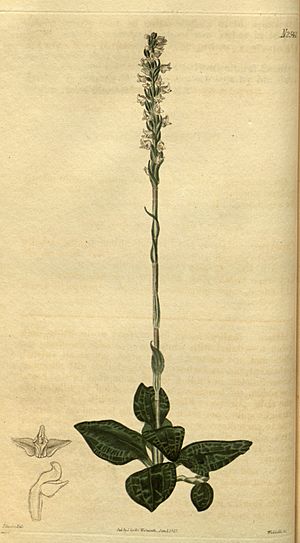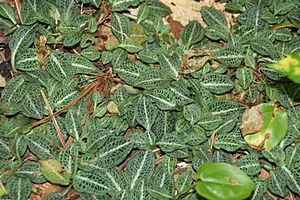Downy rattlesnake plantain facts for kids
Quick facts for kids Downy rattlesnake plantain |
|
|---|---|
 |
|
| An illustration from 1825 | |
| Scientific classification | |
| Genus: |
Goodyera
|
| Species: |
pubescens
|
The downy rattlesnake plantain (Goodyera pubescens) is a common type of orchid that grows naturally in eastern North America. You can find it from Florida all the way up to Nova Scotia, and west to places like eastern Oklahoma, Minnesota, and Ontario.
This plant is an evergreen herb, meaning its leaves stay green all year. Its leaves are quite special because they have a cool pattern of light green veins that look like a network or a net. This plant spreads by sending out short stems called stolons along the ground. It usually grows on land, but sometimes you can find it on rock shelves. It likes soil that is a little bit acidic, often found in oak-heath forests.
Contents
What is the Downy Rattlesnake Plantain?
The downy rattlesnake plantain is a plant that belongs to the Orchidaceae (orchid) family. It's often found across North America. Plants in the Goodyera group are ground-dwelling orchids with thick roots called rhizomes. They have evergreen leaves that grow in a circular pattern at the base, often with white or light green markings.
The flowers grow on a spike, usually white with green or brown spots, and they smell nice. Most parts of the plant, except for the petals, are covered in tiny hairs. A key difference between Goodyera and a similar group called Spiranthes is that Goodyera plants have oval-shaped leaves with white or light green patterns.
How does the Downy Rattlesnake Plantain look?
The downy rattlesnake plantain blooms from mid-July to early September. It produces a small spike of 10 to 57 tube-shaped flowers. The leaves are broad and oval-shaped (about 2 to 6 cm long and 1 to 3 cm wide). They have a unique white-green pattern of veins all over them, which makes them look like snakeskin. This is why they are called "rattlesnake plantains."
The flower stalk, called a peduncle, can be 11 to 35 cm long. The flowers themselves have sepals (leaf-like parts protecting the bud) that are about 3 to 5 mm long, and petals that are 3 to 5 mm long. The lip of the flower is shaped like a pouch and is a bit bumpy on the outside.
What plants look similar to it?
There are other Goodyera species that can look similar to the downy rattlesnake plantain.
- The Dwarf Rattlesnake plantain (G. repens) has smaller flowers that only grow on one side of the stalk.
- G. tesselata and G. oblongifolia are mostly found in Canada.
- Goodyera tesselata has dull green leaves with much lighter veins.
- G. oblongifolia leaves only have one main vein, unlike the dense network of veins on G. pubescens.
Where does the Downy Rattlesnake Plantain grow?
The downy rattlesnake plantain is found across much of eastern North America. Its range stretches from Florida in the south all the way north to Ontario in Canada, and as far west as Oklahoma. It grows in many states in the USA and provinces in Canada.
What kind of places does it like to live in?
This plant grows best in forests that are not too wet or too dry. It prefers soil that drains well and is slightly acidic, often with a good amount of sand. It needs a lot of shade from trees or bushes. If smaller bushes grow too tall, they can sometimes block out the light the plant needs.
Good drainage is very important because orchids can die if their soil gets too wet. You can find this plant in both dry and moist areas, in sandy or clay-rich soils. It grows well in forests with either deciduous trees (which lose their leaves) or coniferous trees (like pines), as long as they provide enough partial shade. The downy rattlesnake plantain is also considered a "National Wetland Indicator Species," which means it can help show if an area is a wetland.
How does the Downy Rattlesnake Plantain live?
Compared to other types of orchids, Goodyera plants are quite tough. They can survive in colder weather, use different kinds of nutrients, and grow in various soil types and light conditions. The downy rattlesnake plantain has a very high germination rate (over 90%) even in cold places, which is why it's found in northern parts of the US and Canada.
This plant prefers loamy soils (a mix of sand, silt, and clay) or humus (decayed organic matter). It can also grow on decaying wood, especially from trees like tulip poplars or white oaks, particularly if there's a lot of fungal activity. However, its roots cannot survive very harsh winters at the northern edge of its range.
How does it grow and reproduce?
The downy rattlesnake plantain grows from a rhizome, spreading out in a group. It only flowers once a year after it reaches maturity, which can take 4 to 8 years. After it flowers, the parent plant usually dies, but it sends out 1 to 3 new shoots that grow into new plants. Many individual plants don't live long enough to reach maturity and flower.
Mature plants flower after a dry period in the spring, usually in May, when temperatures are higher than average. These exact conditions might not happen every year, which explains why it takes so long for the plant to mature.

White-tailed deer (Odocoileus virginianus) enjoy eating the leaves, rosettes (leaf clusters), and flowers of this plant. As deer populations have grown over the past few decades, the number of rosettes per plant has increased. This helps the plant survive even when deer eat some of them.
What are its uses?
Today, the downy rattlesnake plantain is mostly grown for its beauty. People like to keep it in terrariums or in wildflower gardens because of its interesting leaf patterns and its toughness.
In the past, Native Americans used this plant as a medicine for many different problems.
- They made a tea from the roots to help with lung problems, breathing pain, and snakebites.
- The leaves were used to help with appetite, colds, kidney issues, joint pain, and even toothaches.
- Wilted leaves were used to cool burns, treat skin ulcers, or relieve pain.
It's important to remember that these are historical or cultural uses and are not recommended for modern medical treatment.
Is the Downy Rattlesnake Plantain in danger?
This orchid is one of the more common species found in the United States. For the most part, it is not considered to be threatened or at risk of disappearing. However, there are a couple of places where it is a concern:
- In Florida, this species is considered endangered.
- In New York, it is considered "exploitably vulnerable," meaning it could become threatened if not managed carefully.
How did it get its name?
The group of plants called Goodyera is also commonly known as the "rattlesnake plantain." This name comes from the snake-like pattern of veins on their leaves, which looks a bit like snakeskin. The downy rattlesnake plantain (Goodyera pubescens) was first officially described in 1813. Its current name, Goodyera pubescens, is the accepted and correct name for this species.
Can you grow the Downy Rattlesnake Plantain in a garden?
Many gardeners find this orchid beautiful and want to grow it. However, keeping it alive outside of its natural habitat can be quite difficult. It needs specific conditions like infrequent sunlight, acidic soil, a lot of fungal activity, and good drainage. These needs make it hard to grow in typical gardens.
You can usually only find this plant in special nurseries. Taking it from the wild is not encouraged and will likely cause the plant to die.
Images for kids



